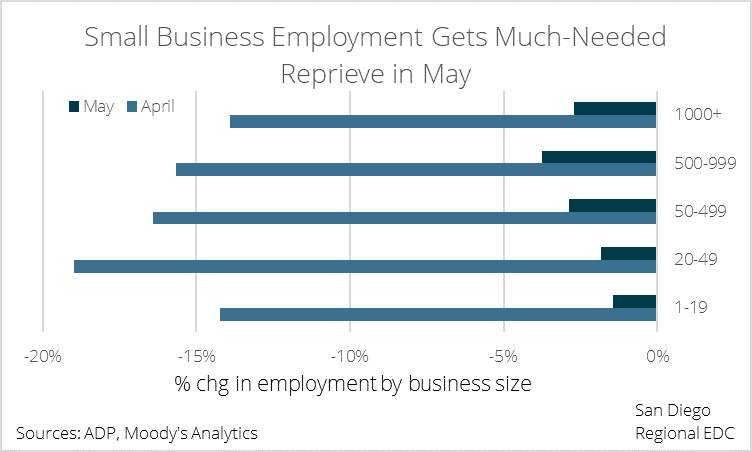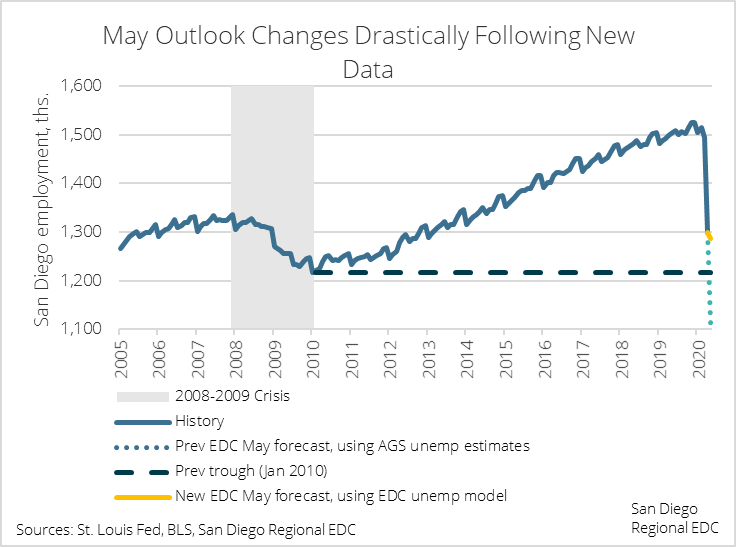- EDC projects SD unemployment to peak at around 16 percent in May, far less than externally produced estimates of 30 percent or more
- While the U.S. recovered jobs in May, gains are most likely concentrated in states and cities that have reopened ahead of California
- SD job growth will resume in the Summer months but could level off in the Fall until a vaccine is widely available
May’s employment picture might not be as bad as initially feared. A couple of weeks ago, we published a report that stated the May job cuts in San Diego could potentially be on par with the extraordinary losses suffered in April’s employment report. Those numbers were based on estimates for local retail sales along with city and county unemployment rates that were produced externally. While the estimates for more than a 50 percent decline in retail sales from February to May don’t seem unreasonable, it appears that the May unemployment rate projection of 30 percent or higher is well above the official rate to be reported by the Labor Department on June 19.
OUTLOOK IMPROVES ON INCOMING DATA
San Diego unemployment correlates closely with California continuing unemployment insurance (“UI”) claims. Continuing UI claims in California averaged about 2.9 million in May—above the 2.6 million registered in April, but certainly not enough to double unemployment across the state, including San Diego. EDC estimates that May unemployment in the region will be reported at closer to 16 percent, up from 15 percent in April and nearly half the rate estimated earlier during the pandemic.
EDC’s much lower unemployment projection is supported by incoming state and national data. For instance, the U.S. unemployment rate was reported as 13.3 percent in May, down from 14.7 percent in April. San Diego unemployment has differed from the national rate at times, but the probability that San Diego unemployment would have settled at a level at or above 30 percent given the lower national figure is, in essence, a statistical impossibility.
Additionally, the ADP national employment report showed that small business job losses slowed considerably in May from April. Small businesses employ 45 percent of the San Diego workforce, compared with just 29 percent nationally, suggesting that layoffs have abated for a wider swath of the local labor force than for the U.S. as a whole.

Taken together, the May jobs report for San Diego is anticipated to show an additional 10,000 to 15,000 job losses. While it would have been unfathomable to cheer on such a report just a few months ago, it is far less than the 150,000 to 175,000 job cuts implied by the 30 percent unemployment estimates produced earlier and also strongly suggests that the worst of the COVID slowdown has passed.

THE ELEPHANT IN THE ROOM
The May job cuts projected by EDC for San Diego may seem to contradict the official U.S. job figures released last Friday that showed 2.5 million job gains and a lower unemployment rate. However, the gains in the national report almost certainly reflect jobs that were recovered in states and cities that reopened ahead of California. San Diego has moved to reopen somewhat faster than other areas of the state. Even so, it would be surprising if local job growth is registered ahead of the June employment report, because the May employment figures were estimated on data received during the week of May 12, before local businesses began to reopen.
THE ROAD AHEAD
Barring a second wave of COVID-19, employment in San Diego is expected to start climbing again in June, but the region is unlikely to recoup the jobs lost since February for quite some time. Businesses will call back a sizable portion of their workers as they reopen, but a return to normal for the local job market won’t take hold until after a vaccine has been made widely available. After an initial bump in the summer months, job growth will likely continue at a much more measured pace until consumers begin to feel comfortable venturing out into larger crowds and businesses can once again operate at full capacity—something that most likely will not happen before 2021.
For more COVID-19 recovery resources and information, please visit this page.
Regardless of how this all plays out, EDC is here to help. You can use the button below to request our assistance with finding information, applying to relief programs, and more.
You also might like: